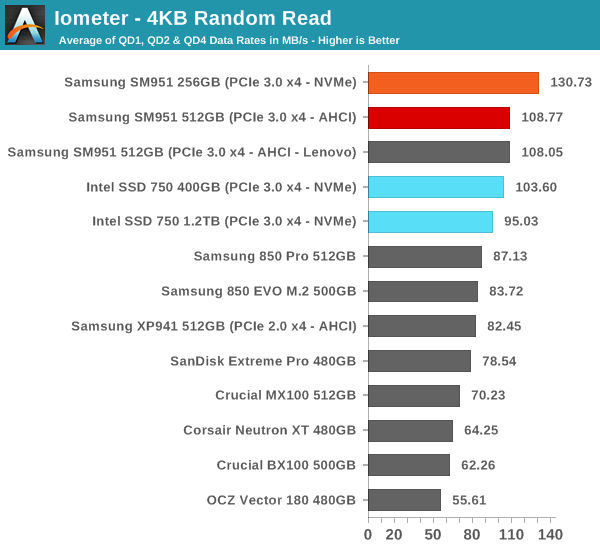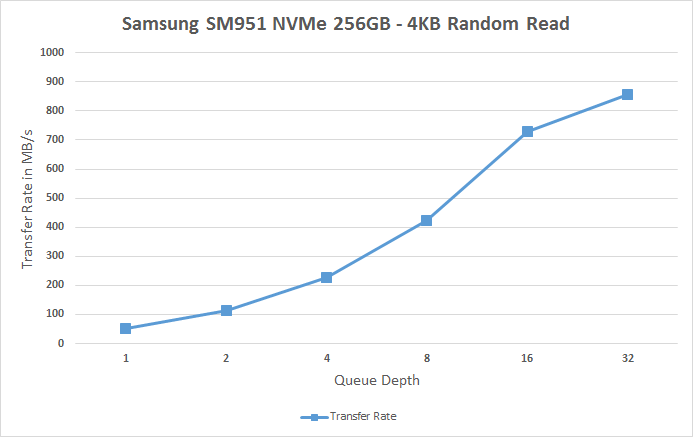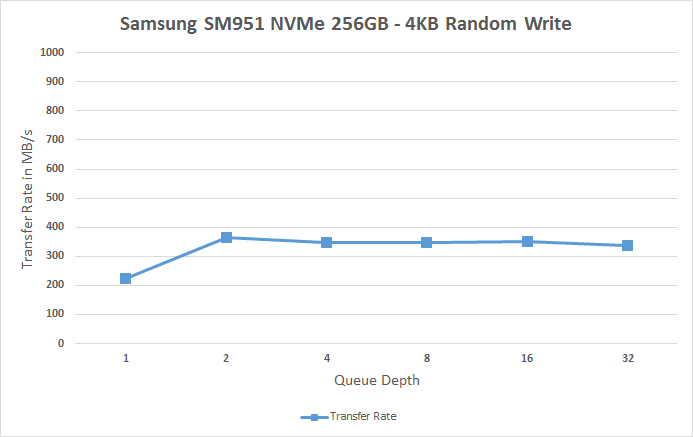Samsung SM951-NVMe (256GB) PCIe SSD Review
by Kristian Vättö on June 25, 2015 9:40 AM ESTRandom Read Performance
For full details of how we conduct our Iometer tests, please refer to this article.

This is the graph I've been dying to see ever since I first heard about NVMe. Random read performance at low queue depths was mostly bottlenecked by AHCI latency because at QD1 the controller can only read from one NAND die (it's asked to read one 4KB chunk of data at a time), meaning that a tremendous share of the latency was caused by the command overhead. As the NVMe command set is much simpler and the whole IO stack is lighter, it opens the doors for improved low queue depth performance, which is exactly what we are seeing with the SM951 NVMe.
 |
|||||||||
| Default | |||||||||
At QD1 the SM951 NVMe offers about 50MB/s, whereas the best AHCI drives I've seen hover around 30-35MB/s, resulting in about 50% gains. Performance at QD2 and QD4 is also better than what other drives offer and in general the SM951 NVMe has excellent random read performance including the high QDs as well.
Random Write Performance

NVMe doesn't present similar gains to random write performance, though. This is an area where Intel clearly has an advantage, but given that the SSD 750 carries an 18-channel controller that is hardly a surprise. Moreover, because the SSD 750 features full power loss protection Intel can cache more user data in the DRAM buffer without the risk of data loss, which can further improve random write performance as IOs can be combined more efficiently. Intel's custom driver may also help with random write performance because the native Microsoft driver has some write performance issues due to Force Unit Access (basically FUA won't consider write to be complete until it has been written to its final medium i.e. NAND, whereas Intel's driver can consider write to be complete when it reaches the DRAM buffer).
 |
|||||||||
| Default | |||||||||










74 Comments
View All Comments
patrickjp93 - Thursday, June 25, 2015 - link
They aren't all storage transfer commands go through the PCH. Your PCIe SSDs do not connect to the CPU directly in most cases. Some enterprise grade drives do, but most consumer do not.Kristian Vättö - Friday, June 26, 2015 - link
PCIe is PCIe regardless of whether the controller is inside the CPU or PCH. PCH merely acts as a hub for different interfaces, but ultimately it connects to the CPU as well since that is where all the processing is done.CajunArson - Thursday, June 25, 2015 - link
Yeah so are we missing some sound and FURY [hint hint] about this SSD on a stick?Kristian Vättö - Thursday, June 25, 2015 - link
Fury X is coming, Ryan just needed one more day because the flu has been undermining his ability to work.DigitalFreak - Thursday, June 25, 2015 - link
(hint hint) The 980ti is faster than the Fury X all around.CajunArson - Thursday, June 25, 2015 - link
I'm not disagreeing with that statement.I just want the review.
lilmoe - Thursday, June 25, 2015 - link
+1A DX12 showdown between FuryX and 980ti would be highly welcome as well.
Gigaplex - Thursday, June 25, 2015 - link
The Fury X wins in some of the 4k tests. The 980Ti seems faster overall, but it's not "all around".mr_tawan - Friday, June 26, 2015 - link
From what I've read, it looks like the Fury has advantages when it comes to memory-intensive use case.SofS - Thursday, June 25, 2015 - link
About the driver issue, how do different operating systems fare? Like 32/64 bits, XP/7/8/10 and Linux old/new (for instance CentOS/Fedora).